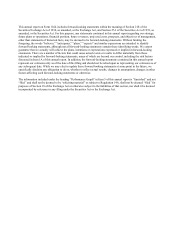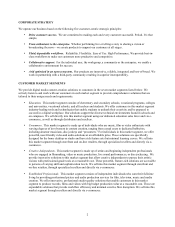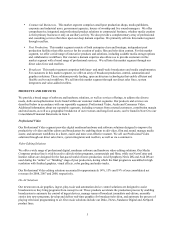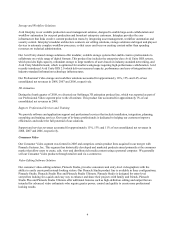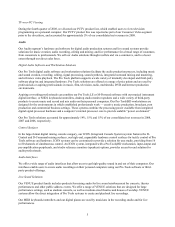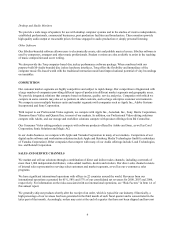Avid 2008 Annual Report Download - page 15
Download and view the complete annual report
Please find page 15 of the 2008 Avid annual report below. You can navigate through the pages in the report by either clicking on the pages listed below, or by using the keyword search tool below to find specific information within the annual report.10
• mix of products and services sold;
• our ability to recognize revenues from large or enterprise-wide sales;
• length of sales cycles and associated costs;
• global macroeconomic conditions;
• changes in operating expenses;
• changes in foreign currency exchange rates;
• reliance on third-party reseller and distribution channels;
• remedial costs and reputational harm associated with product defects or errors;
• cost of third-party technology or components incorporated into or bundled with products sold;
• seasonal factors, such as higher consumer demand at year-end; and
• price protections and provisions for inventory obsolescence extended to resellers and distributors.
The occurrence and interaction of these variables may cause our revenues and operating results to fluctuate from period
to period. As a result, period-to-period comparisons of our revenues and operating results may not provide a good
indication of our future performance.
We expect the global economic downturn to continue to have a negative impact our business, although the
magnitude of that impact is uncertain.
We believe that the global economic downturn negatively affected our revenues and operating results in 2008. We
expect that trend to continue in the future, although we are unable to predict the duration of the downturn or the
magnitude of its impact on our business. To the extent our customers have been or expect to be negatively impacted by
the economic downturn in their own businesses, we anticipate that they may delay or postpone purchases of our
solutions. Of additional concern, certain of our professional customers rely on credit to finance purchases of our
solutions, including through third-party leasing arrangements that we offer. Credit markets have generally tightened in
recent months. To the extent credit is unavailable, even customers otherwise willing to proceed with purchases might be
unable to do so unless or until they are able to arrange for alternative financing. Additionally, certain of our customers
have become insolvent, and others may become so in the future. Even among our solvent customers, we have seen, and
expect to continue to see, an increase in past-due accounts receivable. We may consequently be unable to maintain our
historical collection rates, which would negatively affect our revenues, or, in some circumstances, we may have to
consider extended or alternative payment arrangements, which could delay revenue recognition.
We may also be affected to the extent the economic downturn negatively impacts our resellers and distributors. Our
resellers and distributors have in some cases, and may in the future, reduce on-hand inventory of our products as a
precaution. The downturn has also caused certain of our resellers and distributors, and may cause others, particularly in
the retail sector, to seek bankruptcy protection. With respect to any reseller or distributor that enters bankruptcy, we
may be unable to collect from that reseller or distributor monies due to us or arrange for the return of unsold inventory.
The market segments in which we operate are highly competitive, and our competitors may be able to draw upon
a greater depth and breadth of resources than those that are available to us.
We operate in highly competitive market segments characterized by pressure to innovate, expand feature sets and
functionality, accelerate new product releases and reduce prices. Markets for certain of our consumer products also have
limited barriers to entry. Customers consider many factors when evaluating our products relative to those of our
competitors, including innovation, ease of use, feature sets, functionality, reliability, performance, reputation, and
training and support, and we may not compare favorably against our competitors in all respects. Some of our current
and potential competitors have longer operating histories, greater brand recognition and substantially greater financial,


